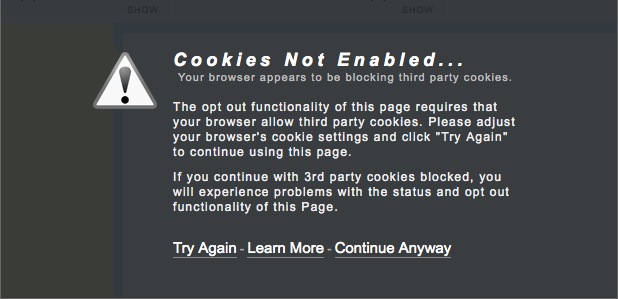FTC Advocates Do-Not-Track; Advertisers Upset
December 3, 2010

Screen capture from the Interactive Advertising Bureau's "AboutAds.info" opt-out page. To install the IAB's opt-out software, users must expose their browser to significant privacy risks by enabling cookies.
On December 1, the U.S. Federal Trade Commission presented a preliminary report (PDF) outlining a “framework for privacy” that endorses a “Do-Not-Track” option for Web browsers similar to the agency’s popular “Do-Not-Call” service for telephones.
Unlike the Do-Not-Call program, which creates one central place where individuals can easily add their phone numbers to the list, with reprisals for companies that violate their preferences, the Do-Not-Track mechanism (“DNT”) will be built into the Web-browsing software and other applications used to access the Internet from computers, tablets, and smartphones. Each piece of software or app would have to include a DNT feature. Currently, there are no proposed guidelines for consistently implementing that feature, nor any real authority to enforce it.
Forbes‘ new privacy blogger, Kashmir Hill, says, “At the end of the day, this report isn’t going to change anything.” Kevin Fogarty, the highly opinionated blogger for ITworld‘s “CoreIT” blog, is blunt in his assessment, calling the FTC report:
[…] a set of recommendations with roughly the same clarity, credibility and impact of a strongly worded letter from the U.N. to this year’s evil dictator asking him to please not kill and eat so many villagers.
At The Huffington Post, consumer rights activist Jamie Court threatens a privacy initiative in California: “If Congress doesn’t act, we will go to the ballot.”
While Internet giants, including Google and Microsoft, have learned to tame their public pronouncements and pay lip service to the FTC’s recommendations, they let the trade groups they fund do the barking for them. Mike Zaneis, senior vice president and general counsel of the Interactive Advertising Bureau (IAB), is quoted by The New York Times media reporters Edward Wyatt and Tanzina Vega as saying that the DNT mechanism will cause “significant economic harm” if it has “a high participation rate similar to that of do not call.”
The IAB is recommending voluntary measures where sites place prominent “opt-out” buttons that disable tracking, rather than a central registry or browser build-ins. The organization touts its AboutAds.info site, where you can opt out of being tracked by a very small group of sites that participate.
John and Carrie Vanston devote a major section of their new book, MINITRENDS, to business opportunities arising from increasing interest in privacy. They predict that the U.S. will strengthen its privacy laws, opening up profitable new business lines for entrepreneurs:
The federal government of the United States has adopted only limited formal legislation to protect privacy compared to Canada and most European countries.
Among the businesses that will profit from strengthening privacy laws are software developers, training firms, and the new field of online reputation management companies.
Certainly, someone needs to come up with a solution better than the IAB’s “opt-out” site. When this reporter visited the site to test the opt-out features, I was advised I would have to enable cookies in order to install the software (see screen capture, above). While enabling cookies would protect me from being tracked by few dozen sites participating in the IAB’s program, it would open me to tracking by the millions of sites that not only don’t participate, but sometimes use methods that are much more intrusive than those of IAB’s supporters — methods which remain, unfortunately, virtually unregulated.
STEVE O’KEEFE
News Editor, Minitrends Blog
Source: “Protecting Consumer Privacy in an Era of Rapid Change” (PDF), Federal Trade Commission, 12/10
Source: “Brief Takeaways — and a Pretty Diagram — from the FTC’s Online Privacy Recommendations,” Forbes, 12/01/10
Source: “FTC becomes aware there is an Internet,” ITworld CoreIT Blog, 11/17/10
Source: “Will We Get a ‘Do Not Track Me’ List for Our Personal Information Online?” The Huffington Post, 12/01/10
Source: “F.T.C. Backs Plan to Honor Privacy of Online Users,” The New York Times, 12/01/10
Source: MINITRENDS How Innovators & Entrepreneurs Discover & Profit From Business & Technology Trends, p. 97.
Image from AboutAds.info, the Interactive Advertising Bureau’s “opt-out” site, screen capture recorded 12/02/10. Used under Fair Use: Commentary.
New Employment Trend: No Employment
November 19, 2010
 A pair of stories in The Wall Street Journal on Friday, November 19, illustrate a growing trend for startup companies: avoiding hiring any employees.
A pair of stories in The Wall Street Journal on Friday, November 19, illustrate a growing trend for startup companies: avoiding hiring any employees.
Pulitzer-Prize winning journalist, Mark Whitehouse, who recently joined the Journal‘s New York office as a senior economics correspondent after years working in Russia, profiled financial analysis startup, MCAP Research, in Montclair, New Jersey, which epitomizes the lean, new startup environment by eschewing any significant capital investments or hiring employees.
The firm was started two years ago by Efrem Meretab, a native of Eritrea, who gave up his job as a stock analyst to open the ultra-lean company. Whitehouse says,
His experience demonstrates how advances in technology and communications are allowing some small companies to sell products world-wide without creating many jobs in the U.S. or spending much money on things made in the U.S.
Whitehouse cites two main factors driving the company’s lean profile: outsourcing programming to the Ukraine and Pakistan while taking advantage of Amazon’s cloud instead of purchasing servers. We have discussed the trend toward cloud computing in many posts on this blog, but never for the solopreneur.
A related story also written by Mark Whitehouse with Justin Lahart, a former CNN/Money correspondent who covers economics for the Journal, reports that startups are not contributing to the growth in employment usually associated with periods of economic recovery.
The number of companies with at least one employee fell by 100,000, or 2%, in the year that ended March 31, the Labor Department reported Thursday. That was the second worst performance in 18 years, the worst being the 3.4% drop in the previous year.
Startups were first hammered by the recession, with more closing that opening since 2008, then strangled by tight capital markets. Angel investing still has not recovered, according to the Center for Venture Research at the University of New Hampshire, which reports that less has been invested in the first half of 2010 than during the recession years of 2008 and 2009.
In their new book, MINITRENDS, John and Carrie Vanston devote a significant portion of the book to new business opportunities serving a growing work-at-home workforce. In a previous post on this blog, we discussed how cloud computing has enabled temp agencies to apply the same just-in-time inventory to the workforce that auto companies have brought to manufacturing.
Without capital to grow their businesses, and with access to a global marketplace of contract workers, companies have learned to prosper by renting rather than buying assets and outsourcing services. If the Vanstons are correct — and their track record (PDF) on such predictions is excellent — the solopreneur will no longer be a trend coming out of this recession but the new standard operating procedure.
We welcome your thoughts about this ultra-lean method of bootstrapping high-tech businesses.
STEVE O’KEEFE
News Editor, Minitrends Blog
Source: “Starting a Global Business, With No U.S. Employees,” The Wall Street Journal, 11/19/10
Source: “Few Businesses Sprout, With Even Fewer Jobs,” The Wall Street Journal, 11/19/10
Photo courtesy of psd (Paul Downey), used under its Creative Commons license.
Information Security Victim to IT Trends
November 9, 2010

Lured by the prospect of reduced costs, more companies are putting their information assets at risk by embracing technology trends such as cloud computing. A new survey finds that companies are failing to assess these risks and take defensive measures.
Consulting giant Ernst & Young released its 13th annual Global Information Security Survey last week, and the privacy picture that emerges is not good. The Vancouver Sun summarizes the findings this way:
Less than a third of global businesses have an IT risk management program capable of addressing the risks related to the use of new technologies… In spite of the rapid emergence of new technology, just one in ten companies consider examining new and emerging IT trends a very important activity for the information security function to perform.
What are the IT trends eroding information security at major corporations?
Mobile Computing, including smartphones, tablets, and laptop computers: “Devices that can contain information are increasingly prevalent; they are used for both work and home purposes, blurring the lines between the two, and results in ceding of control over the devices and the information to employees, service providers and others.”
Cloud Computing, including Software-as-a-Service (SaaS): “While organizations may have chosen in the past to avoid cloud technologies and the possible privacy and security challenges they bring about, in this economic climate, the cost reduction benefits that such solutions offer have brought many organizations to reassess whether these transformational technologies are right for them.”
Social Networking and other “Web 2.0” technologies: “60% perceive increased risk from the use of social networking.”
In their new book, MINITRENDS, John and Carrie Vanston cite increased interest in privacy as one of the most promising areas for entrepreneurial activity in the coming two-to-five years:
In general, communications and computer technologies designed to gather personal information have progressed more rapidly and dramatically than those designed to protect this information. Serious efforts are being expended, however, to develop protection technologies.
The authors suggest some of the avenues for Minitrend development, including making it easier for employees to use privacy-protection software and teaching employees how to protect sensitive information. This insight is bolstered by the Ernst & Young report, in which a whopping 92% of respondents indicate that employee awareness of security issues is a problem.
Information security was a lot easier when it was a matter of protecting the perimeter around a company’s information assets. But in today’s economy, those information assets are widely distributed and stored in the hands of employees and outside vendors, making it much more difficult for organizations to protect them. Clearly, Ernst & Young’s shocking report shows tremendous opportunity for innovators and entrepreneurs who can develop technological solutions to modern privacy problems.
STEVE O’KEEFE
News Editor, Minitrends Blog
Source: “Ernst & Young Report Reveals Companies Unprepared to Address Risks Created by New Technology,” The Vancouver Sun, 11/04/10
Source: “Top privacy issues for 2010,” Ernst & Young, 02/10
Source: “Emerging Technology Trends Increase Risks of Protecting Corporate Information,” PR Newswire, 11/04/10
Source: MINITRENDS: How Innovators & Entrepreneurs Discover & Profit From Business & Technology Trends, Technology Futures, Inc., p. 95.
Photo by D. Sharon Pruitt (Pink Sherbet Photography), used under its Creative Commons license.
Trends Favor Working from Home
November 8, 2010
 A Santa Clara company is combining the hottest technology trends with shifting demographic trends to revolutionize the business of customer service representatives. The firm is called LiveOps, and it’s fair to say the owners have their heads in the clouds.
A Santa Clara company is combining the hottest technology trends with shifting demographic trends to revolutionize the business of customer service representatives. The firm is called LiveOps, and it’s fair to say the owners have their heads in the clouds.
Cloud computing, that is. LiveOps offers several major technology solutions for businesses based on cloud computing. One is called “Workforce in the Cloud,” an on-demand workforce for outsourced call centers. If you operate a call center, you know there are slow times when most of the employees are idle, and peak times where you really could use more staff to handle the volume.
LiveOps solves that problem by allowing you to scale up or down the number of customer service reps available in half-hour increments! The company claims it operates the world’s largest virtual call center, with over 20,000 agents available to handle whatever their clients need.
But don’t think that LiveOps has those agents on a cloud somewhere waiting to be called. LiveOps hires independent contractors on the same basis as it sells its services: in half-hour increments. Work-from-home agents can choose the times they are willing to be available with 30-minute contracts. LiveOps is thus riding the trend of work-from-home contractors that John and Carrie Vanston explore in their new book, MINITRENDS.
“It is estimated that as much as twenty-five percent of all white collar work is now being done in private residences,” say the Vanstons, whose book points out several promising Minitrends in providing services for work-at-home contractors.
LiveOps was profiled in a USA Today article last month by Paul Davidson, who covers economic news for “the nation’s newspaper.” Davidson says that a stunning “68% of the 593,000 jobs added by private employers” since September are temp workers. The trend the Vanston’s explore in their book is accelerating.
Davidson looks at the ups and downs of the issue in a lengthy feature article in a newspaper not known for its depth. The upside is mostly for employers, who find that firing all their workers, losing the company headquarters, and avoiding all those benefits and taxes is liberating. Even if it translates into lower revenues, profits usually improve.
For the employees, the picture is not so rosy. They tend to lose benefits and stability, but enjoy an increase in flexibility and independence. Sometimes they earn more as contract workers than they made as employees.
“It appears likely that the fraction of people working at home will continue to grow,” say the Vanstons. “As a result, the need for support services and facilities — and the market for providing them — will also grow for the foreseeable future.”
STEVE O’KEEFE
News Editor, Minitrends Blog
Source: “Freelance workers reshape companies and jobs,” USA Today, 10/13/10.
Source: MINITRENDS: How Innovators & Entrepreneurs Discover & Profit From Business & Technology Trends, Technology Futures, Inc., pp. 78-81.
Image by Dave Dugdale of rentvine, used under its Creative Commons license.
The Death of Television?
November 3, 2010
 The Consumer Electronics Association recently released its annual Five Technology Trends to Watch report, and it appears we’ve stopped watching TV.
The Consumer Electronics Association recently released its annual Five Technology Trends to Watch report, and it appears we’ve stopped watching TV.
“TV is, in a way, kind of played out,” says Sean Murphy, a senior account executive at the CEA who writes for the trade association’s Digital Dialogue blog. Murphy is quoted by dealnews editorial director Beth Pinsker, who laments that the CEA’s “core areas of interest are now mostly about mobile technologies and the gizmos that make them work better, and no longer about TVs.”
This year’s five technology trends to watch, according to the CEA, are:
- Technology and privacy
- Video distribution and consumption
- Mobile, 4G devices
- Environmental issues
- The apps business
Privacy, or the lack thereof, has been a compelling news story of late. In chapter five of the new book, MINITRENDS, John and Carrie Vanston identify “increased interest in privacy” as one of the trends most suited to entrepreneurial activity, especially for small and medium-sized businesses. Among the other business opportunities resulting from our loss of privacy, the Vanstons cite reputation management:
There will be considerable demand for processes that can remove information from the myriad of databases in which this information may be recorded. Related to this, those offering reputation management services, i.e., tracking an entity’s actions, other entities’ opinions of those actions, and helping the entity manage the results, will be in great demand.
MINITRENDS is a guide to business opportunities that have the promise of profitability in two-to-five years, written by the two of the leading futurists in America. That may seem like a very short time frame, but it’s amazing how things can change quickly. In the CEA report, Deepak Joseph, director of technology and standards at CEA, reflects back on the past five years in streaming video:
In 2006, a host of companies we now closely associate with new video distribution models were not yet founded. Here is a sampling of the current players, Hulu launched March 2007, Netflix streaming service launched January 2007, Apple-TV launched March 2007, Vudu Box launched August 2007, Amazon On-Demand launched July 2008, Yahoo! Connected-TV launched January 2009, YouTube LeanBack launched July 2010 and Google-TV is launching this fall… In 2006, it would have been farfetched to think that 10 million people would view streaming on-demand movies and TV shows, many in HD over their Internet connection on their TVs on a regular basis, yet that is exactly what consumers are doing today with Netflix streaming service.
The same wave of technological change that is making television sets obsolete can also make trade associations obsolete. In the summary essay of CEA’s report, the authors ask whether we are driving technological change, or technology is driving us. As an answer, one need only look at the Consumer Electronics Association itself. The trade organization has seen where its future lies, and is shifting its coverage to mobile devices and online content.
You can access a PDF of the complete report, Five Technology Trends to Watch, at this link.
STEVE O’KEEFE
News Editor, Minitrends Blog
Source: “Five Technology Trends to Watch,” Consumer Electronics Visions, 10/18/10
Source: “CEA’s Top 5 Technology Trends Dismiss TV,” dealnews, 10/20/10
Source: “MINITRENDS: How Innovators & Entrepreneurs Discover & Profit From Business and Technology Trends,” Technology Futures, Inc., p. 99.
Image by schmilblick, used under its Creative Commons license.
Zynga Founder Mark Pincus on Entrepreneurial Success
October 29, 2010
 What is the secret ingredient for successful entrepreneurship? There is one, according to John and Carrie Vanston, authors of the new book, MINITRENDS: How Innovators & Entrepreneurs Discover & Profit From Business & Technology Trends. And it’s not what you might think.
What is the secret ingredient for successful entrepreneurship? There is one, according to John and Carrie Vanston, authors of the new book, MINITRENDS: How Innovators & Entrepreneurs Discover & Profit From Business & Technology Trends. And it’s not what you might think.
Is it tenacity? Nope. Drive? No. Training? Not a major ingredient. Neither is education, wealth, creativity or connections. None of these things show a very strong correlation with entrepreneurial prowess.
Surprise: The one trait that ties together more successful entrepreneurs than anything else is “exceptionally good health.” That’s according to the University of Washington’s Dr. Karl Vesper, who reviewed numerous studies of entrepreneurs looking for underlying patterns.
While he might not recognize it as the most important benefit he provides to over 1,000 employees, entrepreneur Mark Pinkus knows his health and their health is important. It’s the reason his company provides not only excellent health care benefits, but also such perks as onsite dentistry and a free company cafeteria.
Pinkus, whose company, Zynga, has created such popular games as FarmVille and Mafia Wars, was interviewed recently by Kermit Pattison for Fast Company. Pattison specializes in interviews with business leaders. The way he covers Silicon Valley, you would think him a fixture in the San Francisco Bay Area. But he plies his trade from a healthy distance — out of St. Paul, Minnesota.
Asked about Zynga’s food court, Pincus explains:
I started to realize that from a productivity standpoint good food has a multiplier effect. You waste time trying to find food everyday. You feel crappy about a lot of the food you eat. There are positives about building community — food brings people together. If have enough good food in one place, it gives people from different parts of the company reason to sit down together.
Pincus is passionate about entrepreneurship. When he hires managers, he looks for people with that entrepreneurial mindset. “You can be an entrepreneur inside any size company. The best companies today value great entrepreneurs and work hard to retain them and motivate them,” Pinkus told Pattison.
MINITRENDS is built on this same premise: that one can be an entrepreneur in any size company. It’s your job to keep alert to new trends and to choose which directions to embrace and which to steer clear from, whether you are a sole proprietor, part of a small business, or a manager for a large business enterprise.
You’re not going to be successful at that job if you don’t take care of yourself. So learn the real secret of successful entrepreneurs and pay attention to your heath, because you won’t last long in this business without it.
STEVE O’KEEFE
News Editor, Minitrends Blog
Source: “Leveling Up Your Staff: Zynga’s Mark Pincus on Entrepreneurial Companies,” Fast Company, 10/27/10
Source: “Stay Healthy,” MINITRENDS, p. 179.
Image by Identity Photogr@phy (Clare Bell), used under Creative Commons license.


